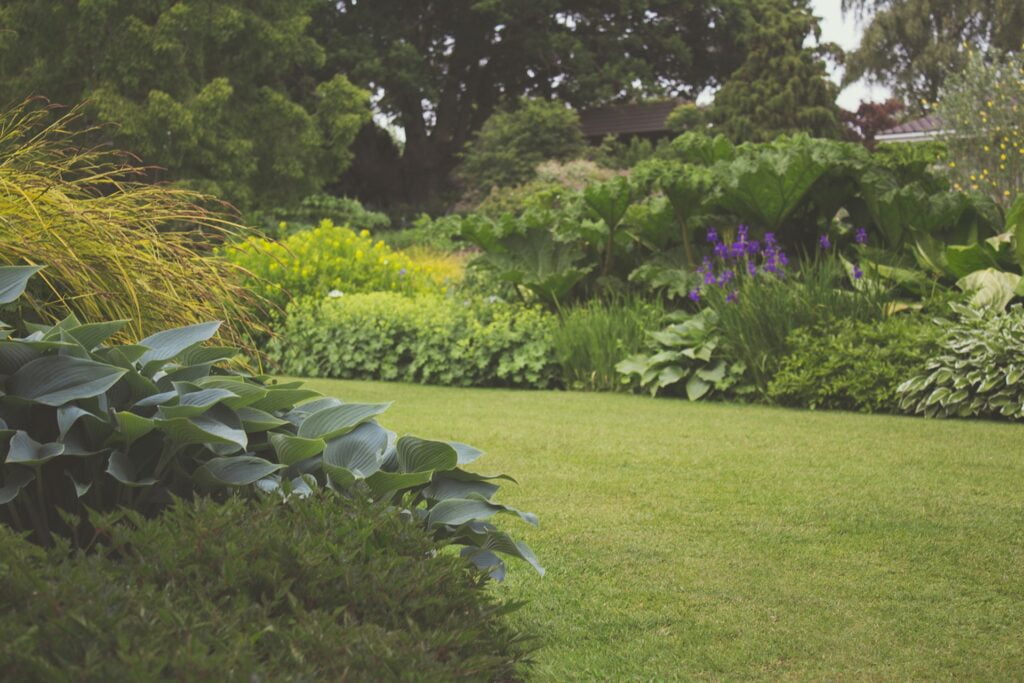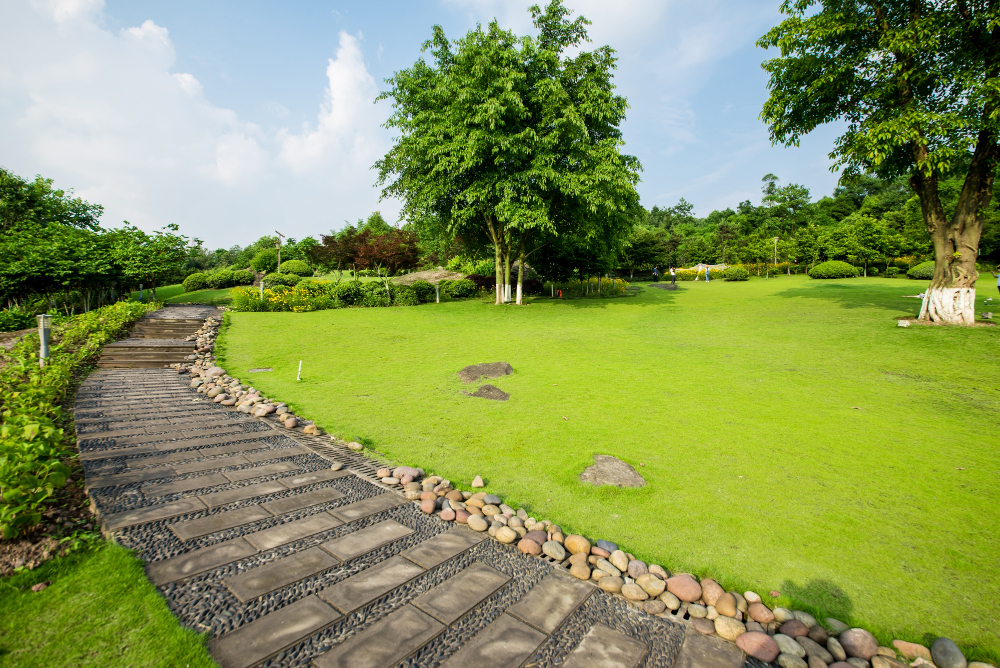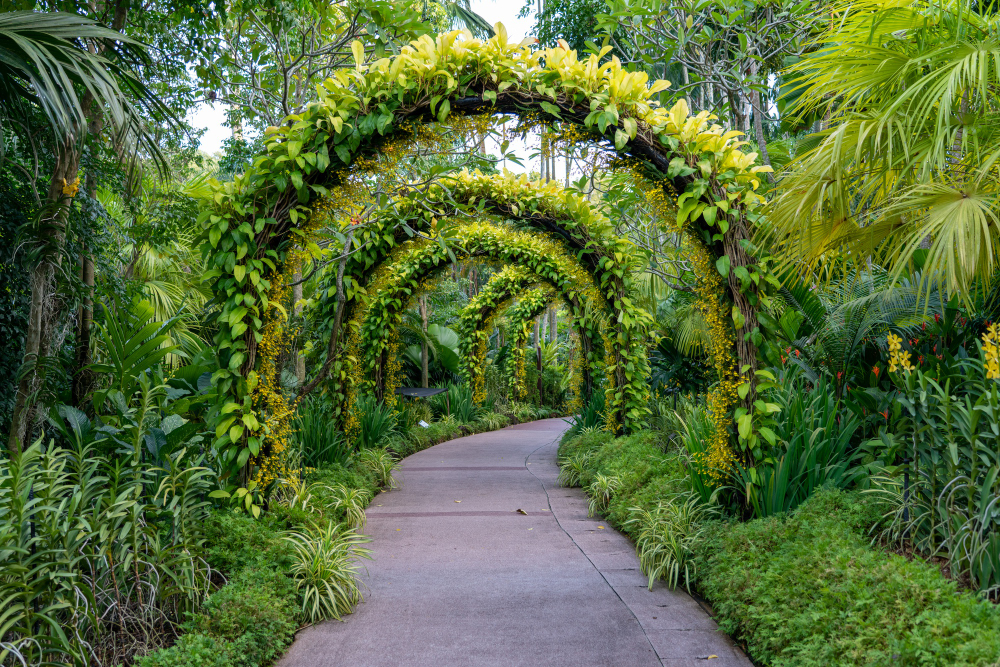Landscape design is more than just planting flowers and trees; it’s about creating a space that resonates with your personality and enhances the beauty of your home. With the right focal points, your landscape design can transform from ordinary to extraordinary. In this guide, we’ll explore eight timeless focal points that can elevate your landscape design in Trumbull, CT.
Key Takeaways
|
Water features have long been a cornerstone of landscape design, offering both aesthetic and functional benefits.
Water features introduce a dynamic element to your landscape design. The sound of flowing water can create a calming ambiance, making your garden a peaceful retreat. Moreover, water features can significantly increase the value of your property, making it a worthy investment for homeowners in Trumbull.
If you’re considering adding a water feature to your landscape design but are unsure about which one to choose or how to integrate it seamlessly, it’s a good idea to consult with professionals. Trumbull Expert Landscapers have extensive experience in designing and installing water features tailored to the specific needs and preferences of homeowners in Trumbull, CT. Their expertise can ensure that your water feature not only enhances the beauty of your garden but also adds value to your property.
Statuary and sculptures have been integral to landscape design for centuries. They offer a unique way to express personal style, tell a story, or pay homage to history and culture.
Garden statues and sculptures can transform an ordinary garden into a visual masterpiece. They serve as conversation starters, evoke emotions, and add a layer of sophistication to any landscape design.
Illuminating your statues and sculptures can enhance their beauty during nighttime. Consider soft spotlights or ambient lighting to highlight the intricate details and create dramatic shadows.
Garden structures play a pivotal role in adding depth, dimension, and functionality to a landscape design. These structures, ranging from ornate to minimalist, can transform an open space into defined areas, each with its purpose and charm.
Unity and harmony are foundational in landscape design. Garden structures serve dual purposes: they provide functional benefits like shade and support, and they introduce architectural elements that break the monotony of green spaces, adding layers to your landscape design.
The choice of material for your garden structure can influence its durability, especially in Trumbull’s varied climate. Common materials include:
When integrating any garden structure, consider its placement, scale, and the overall theme of your garden. For instance, a gazebo might be best placed at a vantage point, while an arbor can mark the entrance to a floral pathway.
Garden structures, with their architectural charm, can elevate the aesthetics of any garden. They provide definition, create focal points, and offer functional spaces within the garden. If you’re considering adding a garden structure to your Trumbull property, integrating it seamlessly into your landscape design will ensure it complements and enhances the overall appeal of your outdoor space.

Ornamental trees are a magnificent addition to any garden, offering beauty, shade, and sometimes even fragrance. These trees, often chosen for their aesthetic appeal rather than fruit or timber, can become the star attractions of your landscape design.
Ornamental trees bring a combination of color, texture, and height to your landscape design. They can serve as standalone focal points, provide privacy, or even act as natural screens against unsightly views.
Choosing and caring for ornamental trees might seem daunting, but with the right guidance, it becomes a rewarding endeavor. If you’re considering adding ornamental trees to your landscape design in Trumbull, CT, it’s a wise decision to consult with Trumbull Expert Landscapers. Their expertise in local flora and landscape design ensures that you select the perfect tree that thrives and enhances the beauty of your property for years to come.

Flower beds and borders are quintessential elements in landscape design, bringing vibrant colors, varied textures, and a sense of life to any garden. They can transform a plain lawn into a tapestry of hues and shapes, making it a visual delight for anyone visiting.
Flower beds are more than just patches of colorful blooms; they are carefully curated compositions that tell a story through their color combinations, height variations, and seasonal changes. They can set the mood of a garden, from a serene white and blue palette to a jubilant mix of bright summer colors.
Borders not only define the edges of flower beds but can also be ornamental in their right. Whether it’s a simple row of boxwood shrubs or a mix of flowering plants, borders add structure and formality to your landscape design.
Using native plants in your flower beds can be beneficial. They are adapted to Trumbull’s climate, require less maintenance, and support local wildlife.
Rock gardens and boulders introduce a unique, rugged charm to landscape design. By blending the hard textures of stones with the softness of plants, they create a harmonious balance that’s both visually appealing and low-maintenance.
Rock gardens, with their minimalist aesthetic and natural appeal, have been cherished by garden enthusiasts for centuries. They offer a serene, Zen-like quality, making them perfect for meditation spaces or areas where one seeks tranquility within their landscape design.
Large boulders can serve as standalone focal points in a garden. They can be used to create elevation, act as natural seating, or even be incorporated into water features. Their imposing size and natural beauty make them a striking addition to any landscape design.
To elevate the beauty of your rock garden, consider adding a water feature. A small stream flowing between rocks or a pond surrounded by boulders can enhance the natural feel and add dynamism to your landscape design.


Garden paths and walkways are more than just functional elements in a garden; they are the veins that guide the flow and narrative of your outdoor space and allow for movement and accessibility in your garden. They lead visitors through the various highlights of your garden, ensuring that every corner is explored and appreciated.
Paths provide structure and order to a garden. They define spaces, create boundaries, and offer a sense of direction. Whether it’s a meandering path through a woodland garden or a straight walkway leading to a focal point, paths play a crucial role in the overall experience of your landscape design.
Designing and installing the perfect garden path requires a keen eye for design and a deep understanding of the garden’s layout and topography. If you’re considering adding or revamping a path in your Trumbull property, consulting with Trumbull Expert Landscapers can be invaluable. Their expertise in landscape design ensures that your path not only looks beautiful but also serves its functional purpose seamlessly.
Seating areas and fire pits are more than just functional additions to a garden; they are the heartbeats of social interactions and memories made outdoors. These spaces invite relaxation, conversation, and warmth, making them indispensable for homeowners.
Outdoor seating areas, whether it’s a simple bench under a tree or a full-fledged patio set, provide a space to relax, entertain, and enjoy the beauty of the outdoors. They act as extensions of the indoor living space, blurring the lines between inside and out, and enhancing the overall usability of your landscape design.
Fire pits are a popular addition to many gardens in Trumbull, CT. They provide warmth on chilly evenings, create a focal point, and offer an inviting space for gatherings.
Q1: What is the difference between landscape design and landscape architecture?
Landscape design primarily focuses on the aesthetic arrangement of gardens and outdoor spaces, often for residential properties. Landscape architecture, on the other hand, is a broader field that encompasses the design of outdoor public areas, landmarks, and structures to achieve environmental, social, or aesthetic outcomes. It often requires formal education and licensing.
Q2: How often should I update or refresh my landscape design?
While a well-designed landscape can last for many years, it’s a good idea to evaluate and refresh your landscape every 5-7 years. This ensures that the plants remain healthy, the design stays modern, and the space continues to meet your changing needs.
Q3: Can I implement a landscape design in stages?
Absolutely! Many homeowners in Trumbull, CT, choose to implement their landscape design in phases due to budget or time constraints. A phased approach allows for flexibility and can also help in understanding how different elements come together over time.
Q4: How do I choose the right plants for my garden in Trumbull, CT?
It’s essential to consider the local climate, soil type, and the amount of sunlight your garden receives. Native plants or those adapted to Trumbull’s conditions are often the best choices as they require less maintenance and are more resistant to local pests and diseases.
Q5: How can I make my landscape design more environmentally friendly?
Consider incorporating sustainable practices like rainwater harvesting, using drought-resistant plants, reducing lawn areas, and using organic mulches and fertilizers. Additionally, creating habitats for local wildlife can also make your garden more eco-friendly.
Your garden is an extension of your home, a place where memories are made, and moments are cherished. If you’re in Trumbull, CT, and looking to elevate your outdoor space to new heights, don’t leave it to chance. Trust the experts who understand the nuances of local landscape design.
Trumbull Expert Landscapers are more than just garden designers; we are artists who paint with plants, stones, and water. With years of experience and a passion for creating stunning outdoor spaces, we are the go-to choice for discerning homeowners in Trumbull. Call us now!
